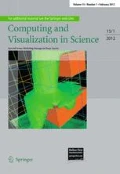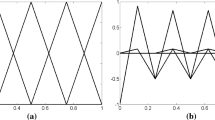Abstract
This paper develops an interface between Computer Aided Design (CAD) and the wavelet Galerkin scheme for boundary integral equations. The key issue is an algorithm that decomposes a technical surface which was generated by CAD tools into a regular collection of parameterized four-sided patches. By a postprocessing step the global continuity of the parametrization is guaranteed. Numerical results are reported to illustrate the approach. In particular, the decomposition techniques are applied to real CAD data which come from IGES files.
Similar content being viewed by others
References
Beylkin G., Coifman R., Rokhlin V.: The fast wavelet transform and numerical algorithms. Commun. Pure Appl. Math. 44, 141–183 (1991)
Brunnett G.: Geometric design with trimmed surfaces. Comput. Suppl. 10, 101–115 (1995)
Cohen A., Daubechies I., Feauveau J.-C.: Biorthogonal bases of compactly supported wavelets. Pure Appl. Math. 45, 485–560 (1992)
Dahmen W., Harbrecht H., Schneider R.: Compression techniques for boundary integral equations—optimal complexity estimates. SIAM J. Numer. Anal. 43, 2251–2271 (2006)
Dahmen W., Kunoth A.: Multilevel preconditioning. Numer. Math. 63, 315–344 (1992)
Dahmen W., Schneider R.: Composite wavelet bases for operator equations. Math. Comput. 68, 1533–1567 (1999)
Dahmen W., Schneider R.: Wavelets on manifolds I construction and domain decomposition. SIAM J. Math. Anal. 31, 184–230 (1999)
Farin G.: Discrete Coons patches. Comput. Aided Geom. Des. 16(7), 691–700 (1999)
Floater M.: Chordal cubic spline interpolation is fourth order accurate. IMA J. Numer. Anal. 26, 25–33 (2006)
Forrest A.: On Coons and other methods for the representation of curved surfaces. Comput. Graph. Image Process. 1, 341–359 (1972)
Gordon W., Hall C.: Construction of curvilinear co-ordinate systems and applications to mesh generation. Int. J. Numer. Methods Eng. 7, 461–477 (1973)
Gordon W., Hall C.: Transfinite element methods: blending-function interpolation over arbitrary curved element domains. Numer. Math. 21, 109–129 (1973)
Gordon, W.: Sculptured surface interpolation via blending-function methods. Research Report, Department of Mathematics and Computer Science, Drexel University, Philadelphia (1982)
Greengard L., Rokhlin V.: A fast algorithm for particle simulation. J. Comput. Phys. 73, 325–348 (1987)
Hackbusch W.: A sparse matrix arithmetic based on \({\mathcal{H}}\) -matrices part I: introduction to \({\mathcal{H}}\) -matrices. Computing 64, 89–108 (1999)
Hackbusch W., Nowak Z.P.: On the fast matrix multiplication in the boundary element method by panel clustering. Numer. Math. 54, 463–491 (1989)
Harbrecht H.: A Newton method for Bernoulli’s free boundary problem in three dimensions. Computing 82, 11–30 (2008)
Harbrecht H., Hohage T.: Fast methods for three-dimensional inverse obstacle scattering. J. Integral Equ. Appl. 19, 237–260 (2007)
Harbrecht H., Schneider R.: Biorthogonal wavelet bases for the boundary element method. Math. Nachr. 269–270, 167–188 (2004)
Harbrecht H., Schneider R.: Wavelet Galerkin schemes for boundary integral equations—implementation and quadrature. SIAM J. Sci. Comput. 27, 1347–1370 (2002)
Harbrecht H., Stevenson R.: Wavelets with patchwise cancellation properties. Math. Comput. 75, 1871–1889 (2006)
Hoschek J., Lasser D.: Grundlagen der Geometrischen Datenverarbeitung. Teubner, Stuttgart (1989)
von Petersdorff T., Schneider R., Schwab C.: Multiwavelets for second kind integral equations. SIAM J. Numer. Anal. 34, 2212–2227 (1997)
Prautzsch H., Boehm W., Paluszny M.: Bézier and B-Spline Techniques. Springer, Berlin (2002)
Randrianarivony, M.: Geometric processing of CAD data and meshes as input of integral equation solvers. PhD thesis, Technische Universität Chemnitz, (2006)
Roulier J.A.: Specifying the arc length of Bézier curves. Comput. Aided Geom. Des. 10, 25–56 (1993)
Schneider R.: Multiskalen- und Wavelet-Matrixkompression: Analysisbasierte Methoden zur Lösung großer vollbesetzter Gleichungssysteme. Teubner, Stuttgart (1998)
Schulze G. : Segmentation operators on Coons’ patches. In: Lyche, T., Schumaker, L. (eds) Mathematical Methods in Computer Aided Geometric Design, pp. 561–572. Academic Press, Boston (1989)
U.S. Product Data Association. Initial graphics exchange specification. IGES 5.3. Trident Research Center, SC, (1996)
Wendland, W.L.: On asymptotic error analysis and underlying mathematical principles for boundary element methods. In: Brebbia C.A. (ed) Boundary Element Techniques in Computer Aided Engineering, NATO ASI Series E-84, pp. 417–436. Martinus Nijhoff, Dordrecht (1984)
Author information
Authors and Affiliations
Corresponding author
Additional information
Communicated by G. Wittum.
Rights and permissions
About this article
Cite this article
Harbrecht, H., Randrianarivony, M. From Computer Aided Design to wavelet BEM. Comput. Visual Sci. 13, 69 (2010). https://doi.org/10.1007/s00791-009-0129-1
Received:
Accepted:
Published:
DOI: https://doi.org/10.1007/s00791-009-0129-1




